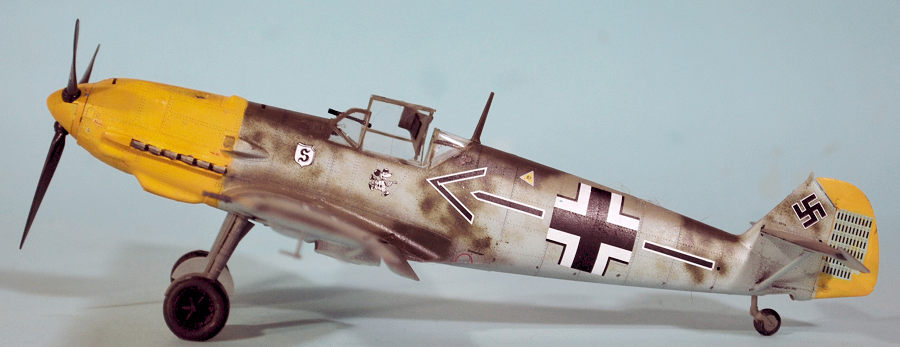
Wingsy 1/48 Bf-109E-4
| KIT #: | D5-10 |
| PRICE: | $35.00 |
| DECALS: | Four options |
| REVIEWER: | Tom Cleaver |
| NOTES: | Eduard decals |

| HISTORY |
Dolfo's Emil:
Since the development history of the Bf-109E series is well-known and available here with other reviews, this will focus on Adolf Galland's role in the development of different camouflage and markings during the Battle of Britain that resulted in the Bf-109E-4N he flew from September 1940 to March 1941.
Before the Second World War, both the Luftwaffe and the Royal Air Force were most concerned with attacks on their aircraft while on the ground. The result was the pre-war Luftwaffe camouflage of two dark greens applied over all the upper surfaces, and the RAF's camouflage of dark earth and dark green on the upper surfaces. Neither of these were good colors for airborne camouflage, since they resulted in very dark colored airplanes that were easily silhouetted against a sky background.
The Luftwaffe was the first to respond to this as a result of their experience of air combat in Poland in September 1939. In January, 1940, the fuselage sides of the Bf-109s were repainted with RLM65 Hellblau extending up the side of the fuselage as far as the cockpit sill. Additionally, the national insignia was enlarged so it would be more visible in air combat. By this time, it had been discovered that the possibility of being shot down by someone on your own side was a real problem, and the issue of air-to-air identification became more important. The British response was to maintain the dark colors since they still expected to be attacked, and to return to the use of fuselage national insignia with the outer yellow ring, for increased visibility and ease of identification.
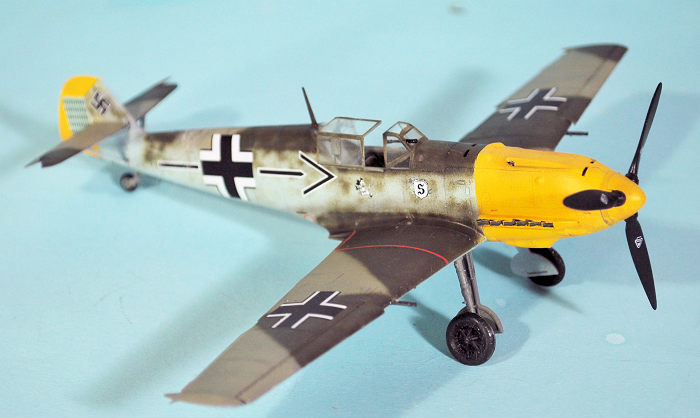
The Jagdgeschwader also experimented with lightening the overall camouflage colors by replacing RLM70 Schwartzgrun with RLM02 Graugrun. By the time of the invasion of the West in May 1940, probably half the German fighters were in this lighter camouflage.
The stage was now set for what would become the Battle of Britain. The early part of the fighting involved air combat over the English Channel, and the Luftwaffe pilots discovered the camouflage they were using was once again inappropriate for the conditions, and that the problem of aerial identification was worse as fighter combat involved larger numbers in quicker fights.
At the time, Adolf Galland was Gruppenkommandeur of III/JG26. He initiated some experiments in camouflage, using RLM65 blue and different greys in different patterns. One aircraft he was known to use at this time was overall RLM65, with RLM75 Grauviolett dappling. Other aircraft used different shades of grey from very light to very dark, in dapple patterns and in more official-looking "splinter" patterns. Additionally, other units were dappling the sides of their aircraft with RLM02, RLM71 Dunkelgrun, and various shades of grey. For modelers, the Bf-109s on the Channel Front during July-September 1940 are a painter's delight, with all these differences.
The issue of air-to-air identification became so important that the groups adopted the practice of painting large areas of the airplane - primarily the nose, the rudder and the wingtips - in bright, easily-spotted colors, generally white or yellow. This would seem counterintuitive to the issue of camouflage, and shows by its presence just how much a problem "friendly fire" was.
Galland moved up to become Kommodore of JG26 on August 18, 1940. Despite the pace of operations, he managed to get the majority of the groups aircraft repainted in the more neutral camouflage colors, and also adopted the practice of painting the entire engine cowling yellow. As a result, JG26 would become known to their RAF opponents as "the yellow noses," or "the yellow-nose Abbeville boys." In fact, other groups such as JG2, JG51 and JG52 also adopted the use of yellow markings at this time. However, JG26's aggressiveness and prowess in battle got them noticed more.
The German armed forces have traditionally considered camouflage very important, and the Reichluftfartministerium (RLM) had been following the issue of camouflage quite closely during this period, looking for a camouflage pattern that could be factory-applied to do the job. By mid-August, they had determined that the best colors were RLM74 Graugrun and RLM75 Grauviolett for the upper surface camouflage, with RLM76 Blaugrau for the lower surfaces, with a dappling on the fuselage sides of RLM02, RLM74 and RLM75. This order went to the factories by the end of August and was implemented quickly.
Galland moved up to become Kommodore of JG26 on August 18, 1940. Despite the pace of operations, he managed to get the majority of the groups aircraft repainted in the more neutral camouflage colors, and also adopted the practice of painting the entire engine cowling yellow. As a result, JG26 would become known to their RAF opponents as "the yellow noses," or "the yellow-nose Abbeville boys." In fact, other groups such as JG2, JG51 and JG52 also adopted the use of yellow markings at this time. However, JG26's aggressiveness and prowess in battle got them noticed more.
The German armed forces have
traditionally considered camouflage very important, and the
Reichluftfartministerium (RLM) had been following the issue of camouflage
quite closely during this period, looking for a camouflage pattern that
could be factory-applied to do the job. By mid-August, they had determined
that the best colors were RLM74 Graugrun and RLM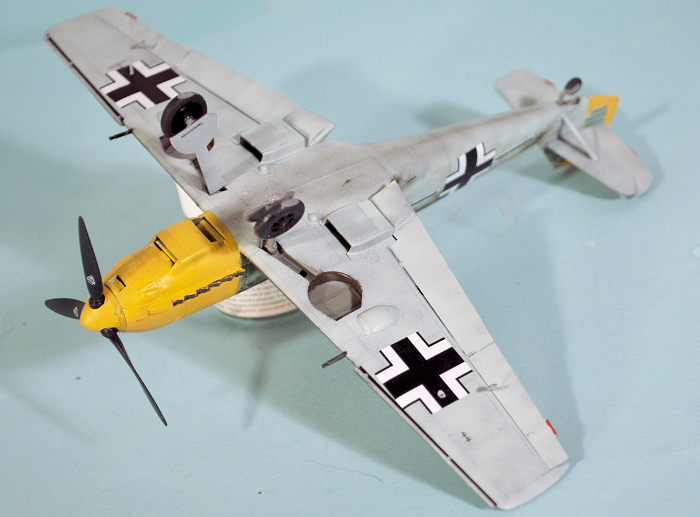 75
Grauviolett for the upper surface camouflage, with RLM76 Blaugrau for the
lower surfaces, with a dappling on the fuselage sides of RLM02, RLM74 and
RLM75. This order went to the factories by the end of August and was
implemented quickly.
75
Grauviolett for the upper surface camouflage, with RLM76 Blaugrau for the
lower surfaces, with a dappling on the fuselage sides of RLM02, RLM74 and
RLM75. This order went to the factories by the end of August and was
implemented quickly.
As one of the leading lights of the Jagdwaffe, Galland received one of the first Bf-109E-4/N, Werkenummer 5819. This aircraft was one of the last to come out of the factory in 71/02 upper camouflage, with much deep dappling on the fuselage sides. Galland had the fuselage repainted with the early 1940 scheme of RLM65 on the fuselage sides up to the cockpit sill and nearly to the top of the rear fuselage. This was then dappled in differing amounts over the time he flew the airplane. JG26 had continued the use of pre-war staff markings, and over the weeks of September, 1940 after he received the airplane around September 10, the "arrow" marking of a Kommodore was applied to the fuselage fore and aft of the insignia, with his traditional "Mickey Mouse" badge finally applied in November, according to photographs of the airplane.
Galland flew this airplane through all the fighting of the later stages of the Battle of Britain and at the beginning of the RAF raids into northern France in 1941. He had it upgraded as later sub-types became available; at the end the fighter was more a Bf-109E-7, having been plumbed for a drop tank. It was always distinctive due to his use of a telescope to identify other aircraft at longer ranges, allowing him to plan his attack.
He scored more victories in this airplane than any other single aircraft he had flown, approximately 30 of his score of 69 at the time the unit was re-equipped with the Bf-109F in March 1941. Galland initially considered the Bf-109F - with its armament of one 15mm cannon and two 7.62mm machine guns - to be a "retrograde step" and continued to fly his Emil until expressly ordered to fly the Friedrich; even then he managed to convince Messerschmitt to provide him with two more heavily-armed airplanes - one with 13mm machine guns that were far more neatly cowled than they would be when officially introduced on the Bf-109G-6, and one with 20mm cannon in the wings, like an Emil.
| THE KIT |
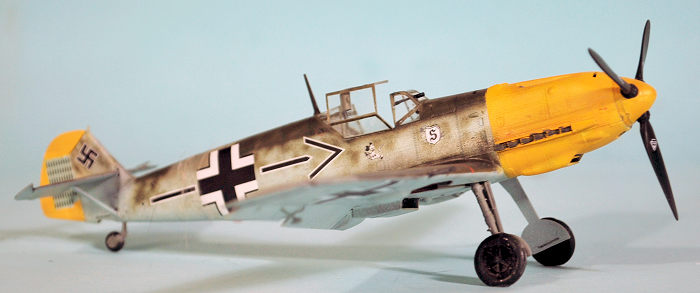
The Wingsy Bf-109E series of kits have superb surface detail; they are the Bf-109E kits that are completely dimensionally correct other than the Airfix Bf 109E kits. This is a high end limited run kit, on a par with kits from Dora Wings, Modelsvit and AMG. In terms of final look, it is thoroughly competitive with anything from Eduard.
I particularly like the fabric control surfaces. Some have said these parts are blank – that’s not accurate, If you hold them under the light, you can see verrryyy subtle “hills and valleys,” the way a fabric covered surface really is!
| CONSTRUCTION |
 I started
with the cockpit and prepainted everything before removing any parts from
the sprue. The kit has decals that snuggle right down on the
injection-molded instrument panel, which is in two parts as it should be.
I started
with the cockpit and prepainted everything before removing any parts from
the sprue. The kit has decals that snuggle right down on the
injection-molded instrument panel, which is in two parts as it should be.
Proceeding to the wing, unmodified the kit results in a model with the flaps raised. However, it was easy to trim the main lower flap hinge at the outer edge of the radiators, which will allow the flap to be positioned down. I also drooped the ailerons the slight bit they were in the landing configuration. The leading edge slats are really good – there is no “ledge” there and the wing looks correct. This is the only 109 kit that does this. I substituted an Eduard prop that I think is more accurate in shape than that provided in the kit.
There are no assembly problems with this kit. Everything goes together without the slightest problem. In fact, I would go so far as to say that in terms of production design and production quality, this beats Tamiya and Eduard can feel a hot breath on their neck.
| COLORS & MARKINGS |
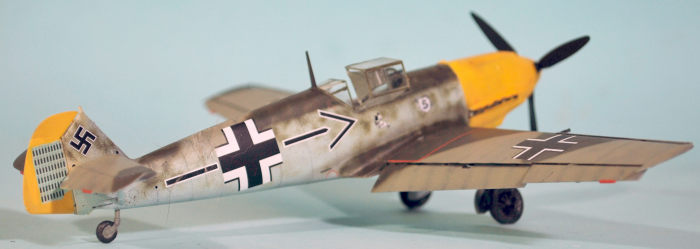 I used the
painting diagram of Galland’s E-4 from the Eduard kit and used Mr. Color
acrylics to give it a 70/71/65 scheme. I think the Mr. Color take on these
colors is be best available. The scheme was freehanded.
I used the
painting diagram of Galland’s E-4 from the Eduard kit and used Mr. Color
acrylics to give it a 70/71/65 scheme. I think the Mr. Color take on these
colors is be best available. The scheme was freehanded.
I used the Eduard decals for Galland’s airplane, and the Wingsy decals for the stenciling. Everything went down without any problems under a coat of Solvaset. I assembled and attached the landing gear, unmasked the canopy and posed it in the open position, and attached the prop.
| CONCLUSIONS |
The Wingsy Bf-109E series of kits are the best Bf-109E kits available in any scale. The surface detail is the equal of anything produced by Eduard, very petite with a very realistic final result. Recommended for any modeler with experience of doing high-end limited-run kits.
Review kit courtesy of Wingsy.
29 February 2024
Back to the Previews Index Page
Back to the Previews Index Page